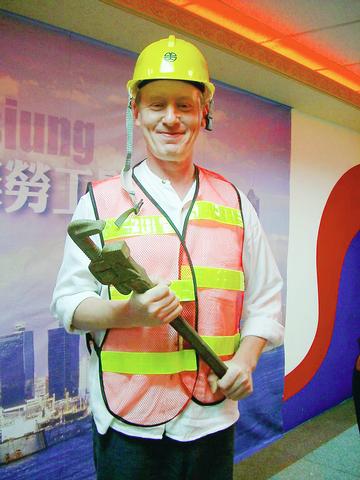For Steve Huison, his role as a British rail track worker in the film Navigator is not just a character he played, but long an issue of concern. The English actor, known internationally as one of the male strippers in The Full Monty, was in Kaohsiung, the city of workers, to join the first International Labor Film Festival yesterday.
Many people likely remember Huison's role as the weakly, unemployed man who tried to commit suicide before Robert Carlye saved him and talked him into joining his comical strip show. But in reality, he is not feeble at all. The son of communist parents, he is not only well-known in film and theater, but a social activist -- a dirty name in Huison's words.
This is perhaps how Huison came to work so closely with renowned filmmaker Ken Loach, who is well-known for his sharp and brilliantly told stories about social concern for the plight of workers. His films include Bread and Roses (1999), My Name is Joe (1998) and Land and Freedom (1995). Loach recently received a nomination for the upcoming 2002 Cannes International Film Festival for his latest work, Sweet 16.

PHOTO: YU SEN-LUN, TAIPEI TIMES
Huison is in Kaohsiung representing Loach's 2001 work, Navigator, as the festival's opening film, and to share the British labor experience with unions in Kaohsiung.
"The film tells a story of real people and real feelings, facing the privatization of state-owned businesses, which is also happening here in Taiwan," Huison said.
Navigator focuses on the privatization of British Rail in 1995. Problems arose when the tracks were divided among different businesses and workers were laid off or forced to adapt to new management. Maintenance costs were cut dangerously low and the ensuing chaos results in the tragic death of a rail track maintenance worker.
Loach's use of a hand-held camera fluently blends black humor with the workers' plight to show the absurdity of privatization.
Also joining the festival as a guest is US documentarian Vivian Price, who has focused on female construction workers around the world. Her film Hammering it Out: Women in the Construction Zone, is a portrait of female construction workers in US. Price said her labor consciousness arose from her own experiences working at construction sites. Price, who has a doctoral degree and is a licensed electrician, said she was fired from one job after another for being a "troublemaker" in the eyes of her employers. She then began filming the plight of female workers.
After arriving Kaohsiung, Price immediately went to local construction sites to film female workers. She said, "I saw the strength in them, some of them have been working for 20 years."
Apart from Hammering it Out and Navigator, there are eight other films showing at the three-day festival which runs from Friday though Sunday. They include Oscar-winner American Dream, a documentary about laborers' struggle with their employer, a famous meat-product packaging company that makes Spam. Also showing is the French documentary Whatever it Costs, about a catering company staffs' struggle with their bosses.
Entrance for all screenings is free. For schedule information visit http://labor.kcg.gov.tw, or call the Cannes Cinema in Kaohsiung at (07) 321-0663.

This is the year that the demographic crisis will begin to impact people’s lives. This will create pressures on treatment and hiring of foreigners. Regardless of whatever technological breakthroughs happen, the real value will come from digesting and productively applying existing technologies in new and creative ways. INTRODUCING BASIC SERVICES BREAKDOWNS At some point soon, we will begin to witness a breakdown in basic services. Initially, it will be limited and sporadic, but the frequency and newsworthiness of the incidents will only continue to accelerate dramatically in the coming years. Here in central Taiwan, many basic services are severely understaffed, and

Jan. 5 to Jan. 11 Of the more than 3,000km of sugar railway that once criss-crossed central and southern Taiwan, just 16.1km remain in operation today. By the time Dafydd Fell began photographing the network in earnest in 1994, it was already well past its heyday. The system had been significantly cut back, leaving behind abandoned stations, rusting rolling stock and crumbling facilities. This reduction continued during the five years of his documentation, adding urgency to his task. As passenger services had already ceased by then, Fell had to wait for the sugarcane harvest season each year, which typically ran from

It is a soulful folk song, filled with feeling and history: A love-stricken young man tells God about his hopes and dreams of happiness. Generations of Uighurs, the Turkic ethnic minority in China’s Xinjiang region, have played it at parties and weddings. But today, if they download it, play it or share it online, they risk ending up in prison. Besh pede, a popular Uighur folk ballad, is among dozens of Uighur-language songs that have been deemed “problematic” by Xinjiang authorities, according to a recording of a meeting held by police and other local officials in the historic city of Kashgar in

It’s a good thing that 2025 is over. Yes, I fully expect we will look back on the year with nostalgia, once we have experienced this year and 2027. Traditionally at New Years much discourse is devoted to discussing what happened the previous year. Let’s have a look at what didn’t happen. Many bad things did not happen. The People’s Republic of China (PRC) did not attack Taiwan. We didn’t have a massive, destructive earthquake or drought. We didn’t have a major human pandemic. No widespread unemployment or other destructive social events. Nothing serious was done about Taiwan’s swelling birth rate catastrophe.